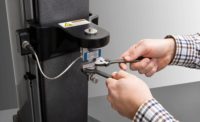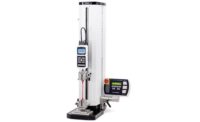Sir Isaac Newton’s three laws of motion, published in his thesis Philosophiæ Naturalis Principia Mathematica (Latin for Mathematical Principles of Natural Philosophy) in 1687, are what modern-day physicists and metrologists refer to when they describe force as any interaction that, if unopposed, will change the motion of an object. Newton’s first law states that objects continue to move in a state of constant velocity unless acted upon by an external net force or resultant force. Newton’s second law builds upon the first by establishing the vector equation: that the momentum of the system is the net (vector sum) force. Finally, Newton’s third law posits that all forces are interactions between different bodies; and that when one body exerts a force on a second body, the second body simultaneously exerts a force equal in magnitude and opposite in direction on the first body.
In manufacturing, force is a quantity on which many other quantities such as torque, thrust, and pressure are based. According to the National Institute of Standards and Technology (NIST), accurate force measurements are required in many applications to “determine the strength of materials, quality control during production, and consumer safety,” among other purposes.
John Cove, marketing manager at The L.S. Starrett Company’s Jedburgh, Scotland location, wrote an article this summer entitled “Everyday Ergonomics: Metrology for the Modern Market” that delves into the importance of force measurement testing in regard to the role that accuracy plays in product development. Cove begins the article with a good-natured warning.
“If you ever stay at the Grand Hyatt hotel in San Francisco,” Cove writes, “don’t be alarmed to receive a note from the staff advising you that the 35-story skyscraper may creak and sway in the wind.”
Most people don’t think about how most skyscrapers are designed to bend in the wind. Something else that the average person doesn’t normally think about is how the devices we use on a daily basis, from smartphones to tablets to remote controls, are likewise attuned and malleable to the force of our fingertips.
“Everything in our world is flexible,” Cove writes. “[And] as the technology and machinery we encounter every day evolves, the requirements of force measurement are only going to advance.”
In the past, Cove notes, force was calculated by using mathematical equations: Newton’s first, second, and third laws. Today, force measurement testing has been limited to handheld metrology devices—and that’s not necessarily a monumental improvement.
“While faster than lengthy calculations and more accurate than guesswork,” Cove explains, “machines do not provide the levels of precision needed for complex structures and modern products.”
The solution, according to Cove, lies in advanced force measurement software. When combined with quality test measurement frames, Cove writes, software like Starrett’s L2 Plus series can offer “a comprehensive analysis of a measurement test—providing data and insight far beyond the basic figures provided by simpler force measurement approaches.”
It’s true that Industry 4.0’s intelligent software is changing every aspect of industrial processes, including force measurement. Moreover, customer satisfaction in this digitized, Cloud-based, and sharing economy-centric era is perhaps more crucial than it’s ever been.
Beyond safety concerns, quality managers must prioritize design and ease of use, and also guarantee that the products they are producing are highly unlikely to fail as the result of a manufacturing error. As Cove highlights, “accuracy is imperative for the development of high quality and ergonomic goods, especially in a climate where end users have come to expect seamless performance from both consumer and industrial devices or machines.”
In the case of the Starrett L2 Plus System, historical test data is archived and available to analyze at a later date, helping speed up future tests and also navigating potential problems or errors. In addition, manufacturers can access high-resolution graphs based on load, distance, height and time of the measurement, simply by exporting measurement data through USB or wirelessly via Bluetooth.
At Ametek, the NEXYGEN DF software is comparably easy to use, as the Windows-based analysis package for digital force and torque gages presents results in a spreadsheet format for data manipulation and statistical calculations. At Mark-10, the MESUR software series expands the functionality of the company’s force and torque gages by including a set of tools to analyze test results, such as customizable reports, pass/fail indicators, statistical calculations, and quick data export to Microsoft Excel.
Quicker does not always equal better, as Cove also emphasized. But what intelligent software can deliver is a kind of insurance for human fallibility—a conundrum in which James Clinton, a technical support specialist at Starrett US, is well-versed.
“Many people are familiar with force and material tests equipment in a production environment to track the quality and consistency of a manufactured product,” Clinton says. But “while standards like ASTM, DIN, TAPPI, and ISO may serve as guidelines,” Clinton notes that “real-world testing of prototypes is required.”
Starrett’s software allows a design engineer to test a part and then analyze the force, distance, and time or strain curves for trends, Clinton explains, which means “there’s no need to try and define everything up front, especially if you’re not sure what you’re looking for.”
With Newton’s laws of motion in mind, I asked Clinton what he thought were some of the key points of innovation throughout the history of force measurement that have brought us to where we are today.
“One of the most prominent innovations in force measurement is moving from devices like a proving ring—a steel ring with an indicator mounted to measure the deflection of the ring as load is applied—to a modern strain gage-based load cell,” Clinton says. “More recent innovations focus on using more intuitive software, [and] exploiting its ability to more rapidly create, run, and analyze tests.”
Time reduction may not be the most important aspect of force measurement, but it’s definitely a top consideration. This is especially true when it comes to competition for consumers accustomed to the instant gratification that the digital economy provides and also to a better work-life balance for employees.
As Clinton reiterates, “The benefits of reducing the time a design or quality engineer needs cannot be understated.”




